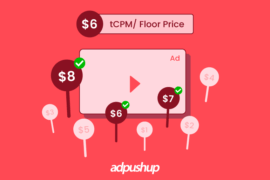Ever-increasing traffic is the dream of bloggers and publishers. But it’s easier said than done. Even when following the best practices of SEO, there is no guarantee of traffic growth.
As content creators, we put (almost) equal efforts into each of our posts. We hope for each post to rank high and get us loads of traffic. A few of these posts do actually make it to the top position. However, with time, post ranking starts to decline—something that’s called “content decay”. This lost ranking is also coupled with a decrease in traffic.
Since Google is the most used search engine (with over 88% market share), I’ll be focusing mainly on traffic loss on Google’s search engine.
Here are the factors leading to a decrease in search ranking and how you can resolve it:
1. Top Post Decay
Most websites follow the 80-20 rule when it comes to their content traffic. Meaning, 80% of the traffic comes from 20% of the content. When the traffic of these 20% posts starts to decline, the website sees a major drop in traffic.
Even if the new posts are doing very well on the website, the traffic loss caused by the natural decay top-performing posts brings down the traffic of the entire site. Hence, relying on top content for the majority of traffic makes publishers vulnerable towards declining organic traffic.
Solution:
Refresh the top content regularly and add up-to-date information to it. Google likes updated pages. Just like content, links also decay after a while, leading to 404 errors. Make sure to check and update the broken on the page while updating it. This leads to an improvement in post quality, Google considers it ‘fresh’ content and ranks it better.
While revamping content has its benefits, don’t forget to publish new content on the website. A constant supply of fresh posts helps maintain the authority of the website.
2. Increased Competition
Just like you, your competitors are publishing loads of content. Everyone understands that content quality heavily affects SERPs. Hence, just doing basic SEO might not get you the position you want.
Consequently, increased search on specific keywords, makes other publishers/bloggers write about it. As they publish new and more informed content, chances are, your page might lose the rank it used to hold.
Solution:
Again, Google values links from reputed domains. Get backlinks from .edu, .org, and recognized domains to rank higher than your competitors. Backlinks from sites with high DA (domain authority) increases the value of your content in a search engine’s eyes.
Next, focus on social sharing. While you can’t magically increase the ranking of your page, you can certainly compensate for lost traffic by pushing your content via social platforms. And if you are still unable to rank for ‘that’ keyword, go for long-tail keywords instead. For instance, if you are losing rank for ‘best smartphones’, you can try ranking for ‘best smartphones under $300’.
3. Loss of Interest
Some keywords lose their volume with time. Here’s a real-life example to explain this statement.
Apple released ITP 2.1 in February 2019 and that’s when we published this blog post. It secured a good rank on Google just after being published. However, slowly the traffic on the blog post decreased as users stopped searching about ‘Apple ITP’. However, later in the month of May and then again in September, Apple released updates to Apple ITP. These updates made users interested in the topic again and hence that blog post received increased traffic during that time.
Users lose interest in specific topics and hence the search volume of keywords goes down.
Solution:
Here, publishers can be facing two problems:
- If user interest in your industry and most topics that you cover is waning—you have a serious problem. The solution here is to switch to a more profitable niche.
- If user interest in a few keywords is waning—you need to add more keywords to your pool and create quality content around them.
4. Seasonality
Depending on the time of the year, user sessions on websites fluctuate. For instance, from mid-November till the new year, businesses see a spike in traffic. This is because of increased shopping activity in the holiday season. Users have spare time and want to buy gifts, and they browse through a lot of websites while making their purchase decisions.
Similarly, during April and May, publishers see a relative decrease in traffic—because of something called the summer slump. All of this happens because of seasonality.
Solution:
While publishers can’t really control the effects of seasonality, they can surely follow some best practices to avoid the bad outcomes associated with it.
Generally, the traffic loss due to seasonality automatically goes away after the market stabilizes. However, if the decrease in traffic continues, then publishers need to re-think their traffic acquisition strategies. To undo the after-effects of the seasonal backslash, add engaging content to the site. Focus on SEO and user experience to make up for lost traffic.
5. Technical Issues
Technical issues involve a wide range of problems like high page load time, indexing errors, lack of SSL certificate, and more. Due to these issues, websites can see a loss in traffic. This happens because of two reasons:
- Search engines—like Google—demote webpages that are slow to load and have indexing problems.
- Also, users don’t like to visit a website that takes too much time to load, hence increasing the bounce rate. This also indirectly affects search rankings.
Solution:
Check whether your website is properly indexed or not. A well-indexed website helps search bots to navigate through the site. Next, monitor whether the traffic on your website is from human users or bots. Sometimes, too much invalid (bot) traffic can lead to loss of website integrity, hence the rankings, and finally the overall traffic.
Invest in a good SEO tool to check the technical issues on your website and fix them. Google Lighthouse is a free tool by Google that lets publishers check the performance of the website. It also generates a report about the technical problems on the website with tips to resolve them.
6. Google Search Algorithm
Google is known to frequently tweak its search algorithm. This is to improve its services and curb SEO malpractices. These changes usually result in a change in already-ranking pages.
According to Backlinko’s research, “On average, moving up 1 spot in the search results will increase CTR by 30.8%. However, this depends on where you’re moving from and to. Moving from position #3 to position #2 will usually result in a significant CTR boost. However, moving from #10 #9 doesn’t make a statistically significant difference.”
Meaning, a change in the SERP, even by one spot, can significantly affect the traffic.
Solution:
Stay updated with the recent changes to the Google search algorithm. Even a small algorithm change can result in big traffic declines.
For instance, the Site Diversity update was released in June 2019 by Google. It makes sure users get more diverse search results instead of seeing the same domain for a particular keyword. This means users will not see more than two results of the same domain on a page for the same keyword.
This update can lead to a decrease in search traffic for publishers who have multiple posts ranking for the same keywords. If this is the case with you, then try ranking the other pages for similar/synonym keywords.
What Have We Learned?
It’s hard to resolve the traffic declines if you don’t know what’s causing it. Along with the above-mentioned factors, your website may be seeing a traffic decline due to numerous other issues—including change in website design and server related problems. Hence, the first step to resolving traffic declines is to identify the root cause(s) and working towards fixing it.
Here is a summary of techniques that can help you get your traffic back and further increase it:
- Refresh content: Update all your high traffic content, add fresh data and new links.
- Add new valuable links: Linking your website helps increase the authority of webpages in search engines. A well-linked website should improve DA.
- Optimize keyword strategy: Keyword trends are always changing. Users are not searching for the same things as they were before. Hence, with time, publishers need to change and improve their keyword strategy. This includes adding new keywords and optimizing the existing ones.
- Study Google search algorithm: Sometimes a change in search algorithms offers a more logical explanation to declining traffic. Try to find the correlation between the search algorithm changes and traffic to mitigate its effects on traffic.

Shubham is a digital marketer with rich experience working in the advertisement technology industry. He has vast experience in the programmatic industry, driving business strategy and scaling functions including but not limited to growth and marketing, Operations, process optimization, and Sales.







